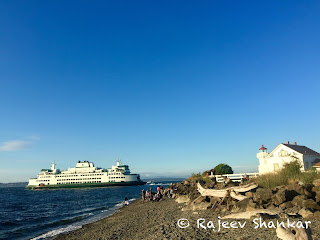 |
| Mukilteo Lighthouse Park, Washington state |
Why do lighthouses move our romantic core? Tall, unsmiling towers are reassuring as they are there to help mariners in treacherous waters reach a safe harbour. A tower holds dual symbolism: on the one hand, it’s mighty, phallic, and erect, denoting strength. On the other hand, it is feminine - suggestive of an enclosed space, a fenced sanctuary, and a safe haven.
Philosophically, a lighthouse symbolises individual consciousness. It’s like ‘a light in the darkness of mere being’, in the words of legendary psychiatrist Carl Jung. Lighthouses remind us of the link we all have to each other, and show us how we can aid each other in a time of urgency.
‘Lighthouses may have come to be seen as brilliant beacons but they are also cenotaphs, marking deathtraps that for centuries devoured mariners along the continent’s coasts,’ wrote Nathaniel Rich, an American novelist and essayist, in a 2016 article in the New York Review of Books.
 |
| A ferry departing the Mukilteo Light on the Puget Sound |
Even though we have been slowly extinguishing our lighthouses, and most of which are seldom operational these days, they remain culturally and symbolically commanding, and retain a strong hold on our imagination.